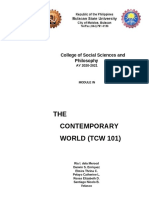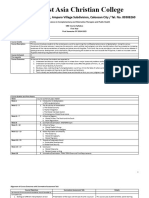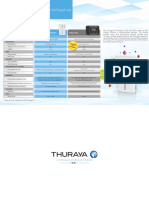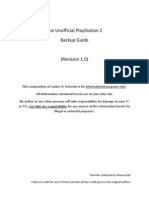Module 1
Uploaded by
Louiz MejaresModule 1
Uploaded by
Louiz MejaresLyceum of the Philippines University - Cavite
College of Arts and Sciences
Social Sciences Department
COURSE MODULE
ON
TCWN01G
THE CONTEMPORARY WORLD
DAN JEFFERSON B. LOPEZ, MA, MPA, LPT
Module Writer
Course Overview
I. Course Introduction
a. Review of University and College VMO
b. Course Description
c. Creative Self-Introduction
d. Setting of Expectations
e. Online Course Policies
f. Course Requirements and Grading System
PRELIMINARY
II. MODULE 1 – INTRODUCTION TO GLOBALIZATION
a. Global Experiences and Some Descriptions
b. Definition of Globalization
c. Positive and Negative Aspects of Globalization
III. MODULE 2 – STRUCTURES OF GLOBALIZATION
a. Globalization and World Economics
b. The Global Interstate System
MIDTERM
IV. MODULE 3 – WORLD OF REGIONS
a. Regionalization and Globalization
b. Global Divides
c. Contemporary Challenges to Regionalism
V. MODULE 4 – WORLD OF IDEAS
a. Globalization and Religion
b. Globalization and Media
c. Global City
FINALS
VI. MODULE 5 – MOVEMENT AND SUSTAINABILITY
a. Global Demography
b. Global Migration
c. Environmental Sustainability and Development
VII. MODULE 6 – GLOBAL CITIZENSHIP AND FOOD SECURITY
a. Global Citizenship
b. Global Food Security
The Contemporary World (TCWN01G) 1
Course Introduction
Vision
An internationally accredited University dedicated to innovation and excellence in the
service of God and Country
Mission
Lyceum of the Philippines University, espousing the ideals of Jose P. Laurel, is committed to
the following missions:
1. Advance and preserve knowledge by undertaking research and disseminating and
utilizing the results. – RESEARCH
2. Provide equitable access to learning through relevant, innovative, industry-based and
environment-conscious programs and services in the context of nationalism and
internationalism. – INSTRUCTION and QUALITY SERVICES
3. Provide necessary knowledge and skills to meet entrepreneurial development and the
managerial requirements of the industry. – INSTRUCTION
4. Establish local and international linkages that will be the source of learning and growth of
the members of academic community. – INSTRUCTION AND INSTITUTIONAL
DEVELOPMENT
5. Support a sustainable community extension program and be a catalyst for social
transformation and custodian of Filipino culture and heritage. – COMMUNITY
EXTENSION
6. Build a community of God-centered, nationalistic, environment conscious, and globally
competitive professionals with wholesome values and attitudes. –
PROFESSIONALISM and VALUES
LPU Core Values
L - Love of God J - Justice
P - Professional Integrity N - Nationalism P - Perseverance
U - Unity L – Leadership
The Contemporary World (TCWN01G) 2
College Vision
The College of Arts and Sciences envisions itself as an accredited Center of Excellence in
the Arts and Sciences. Prospering in a quiet, peaceful and serene resort campus, faculty and
students engage in free and lively interaction to develop creative minds and critical thinking. The
CAS sees itself as a leading institution of higher learning nationally and internationally
recognized for excellence.
College Mission
The College of Arts and Sciences is committed to the following mission:
1. Provide interactive learning experience through Outcomes-Based Education.
2. Provide appropriate knowledge and skills to meet industry requirements.
3. Provide entrepreneurial skills for advancement of self-reliance and sustainability.
4. Provide employable graduates who can compete globally in the field of arts and
sciences and research
Course Description
This course introduces students to the contemporary world by examining the multifaceted
phenomenon of globalization. Using the various disciplines of the social sciences, it examines
the economic, social, political, technological, and other transformations that have created an
increasing awareness of the interconnectedness of peoples and places around the globe. To this
end, the course provides an overview of the various debates in global governance, development,
and sustainability. Beyond exposing the student to the world outside the Philippines, it seeks to
inculcate a sense of global citizenship and global ethical responsibility. This course includes
mandatory topics on population education in the context of population and demography.
Course Outcomes
At the end of the course and given simulated and actual conditions, the student can:
1. Affective
1.1 develop their understanding and appreciation of globalization.
1.2 help them express their personal position on global matters/issues.
1.3 identify the ethical implications of globalization.
2. Cognitive
2.1 provide with general knowledge their various interpretations and approaches to
globalization.
The Contemporary World (TCWN01G) 3
2.2 identify and examine the manifestation of globalization on different areas such as
economy, politics, society, language, and culture.
2.3 assess the effects of globalization on different social units and their responses.
2.4 analyze the role and contribution of the Philippines and its citizen to
globalization.
3. Psychomotor
3.1 prepare and analyze data, articles, researches, and theories in the perspective of
globalization.
3.2 write a research paper on any topic related to globalization.
Online Course Policies
1. Open deadline is implemented for the submission of requirements for the course.
2. The students will be given a score of INC in a requirement which is not submitted or
submitted after the encoding period.
3. Completion of incomplete grades for the First Semester AY 2020-2021 that will expire
shall be extended by one (1) semester from its original due date.
4. Students must be honest at all times; cheating and plagiarism in any form is highly
discouraged.
5. Any concerns (teaching, grades, etc.) against the teacher or against classmates (relative to
the class) should be properly addressed to the subject-teacher for appropriate action.
Students may seek the help and guidance of their academic adviser in resolving the issue
with the subject–teacher.
6. Internet etiquette must be observed at all times.
Course Requirements
1. Major Examination (Prelim, Midterm, Final Exam)
2. Quizzes, Exercises, Activities, etc.
3. Assignments
4. Projects/ Research Paper
The Contemporary World (TCWN01G) 4
Resources Needed
All of the materials such as PowerPoint Presentations, hand-outs, reading materials,
electronic materials will be given by the course instructor.
Grading System
Prelim Exam (PE) 40%
Prelim Period Grade
Creative Academic Performance 60% 100%
(G1)
(CAP) 1
Midterm Exam (ME) 40%
Midterm Period Grade
Creative Academic Performance 60% 100%
(G2)
(CAP) 2
Final Exam (FE) 40%
Final Period Grade
Creative Academic Performance 60% 100%
(G3)
(CAP) 3
Final Grade (FG) = G1 + G2 + G3
3
Self-introduction
For Wired students:
Introduce yourself by participating in the SELF-INTRODUCTION FORUM at myLPU
course site. Kindly indicate the following:
a. Name
b. Course
c. Expectation in the subject
d. Why did you choose your course?
For Non-wired students:
Kindly write the following details on a yellow paper:
a. Name
b. Course
c. Expectation in the subject
d. Why did you choose your course?
The Contemporary World (TCWN01G) 5
MODULE 1
INTRODUCTION TO GLOBALIZATION
The Contemporary World (TCWN01G) 6
MODULE 1
Introduction to Globalization
Module Description:
This module discusses the concept of globalization. It includes lessons explaining some
practical descriptions and experiences of globalization, its working definition of and competing
conceptions, as well as the positive and negative aspects of it.
Intended Learning Outcomes:
At the end of the lesson, the learners should be able to:
Describe global experiences to analyze the various contemporary drivers of globalization.
Identify the competing conceptions of globalization and the underlying philosophies of
the varying definition of globalization applied in different facets of society.
Explain the positive and negative aspects of globalization according to the various
perspective of experts and communities affected by it.
Key Terms
globalization proximity
expansion location
intensification attitude
Global Experiences and Some Descriptions
The development and innovation in transportation, information and communication
technology, sciences, and technological advancements have made the world smaller for all of us.
Hence, the phrase, “the world has shrunk” (Coronacion, et.al, 2018). We are experiencing
globalization starting from our home, economic activities, politics, and social interactions.
Nowadays, it is easy for us to be updated on the news about other countries through different
media especially via internet. Travels and tourism have also become easier with the modern
transportation. Consequently, people are have connected themselves to one another politically,
economically and socio-culturally across borders.
The images below show how globalized our society is.
The Contemporary World (TCWN01G) 7
Today, globalization is no longer about economic aspect but it now relates to other
various sectors of society. According to Martinez, et.al (2018), the following are interrelated
sectors which drive globalization:
Economy
Military
Culture
Ecology
Politics
Technology
Geography
Definition of Globalization
Among the several working definitions of globalization written by scholars, the following
are suggested to clearly understand its meaning:
1. Globalization is the process of expansion and intensification of social relations and
consciousness across world-time and across world-space. Expansion refers to the
creation of new social networks and the multiplication of existing connections that cut
across traditional political, economic, cultural, and geographic boundaries. On the other
hand, intensification pertains to the expansion, stretching, and acceleration of these
networks. (Steger, 2013:15 as cited by Claudio & Abinales, 2018:7-8)
2. According to Levin Institute (2016), globalization is the process of interaction and
integration among the people, companies, and governments of different nations, a process
driven by international trade and investments and aided by information technology. (as
cited by Martinez, et.al, 2018:2)
3. It is usually related to global management and market integration. It consists of three
interrelated factors: (1) proximity; (2) location; and (3) attitude. (Abelos, et.al, 2018)
PROXIMITY LOCATION ATTITUDE
The Contemporary World (TCWN01G) 8
“shrinking globe” “across boundaries” “nothing is overseas
anymore”
refers to the closer access there is transnational open attitude and
of people in sharing management where willingness in
information and having companies or management and
interaction. organizations are participation to various
operating across borders. transactions
internationally.
Claudio and Abinales (2018) cited the different kinds of globalization or “multiple
globalizations” according to Arjun Appadurai. This is classified into five “scapes”, namely:
ethnoscape – global movement of people
mediascape – flow of culture
technoscape – circulation of mechanical goods and software
financescape – global circulation of money
ideoscape – political ideas move around
In-Text-Activity
Watch and Learn!
For further understanding of what globalization means, watch the short YouTube video
entitled, “Globalization explained (explainity® explainer video)” at
https://www.youtube.com/watch?v=JJ0nFD19eT8
Question: What is globalization? How does globalization affect human life? (Post your
answer on the online forum / Submit the printed copy to your instructor.)
Positive and Negative Aspects of Globalization
The Contemporary World (TCWN01G) 9
Globalization has both positive and negative aspects. It could lead to development of the
society and at the same time be harmful in some ways.
Positive Impacts Negative Impacts
gives access to larger market causes environmental damage
provides cheaper goods for consumers causes fluctuation of prices
it lets countries do what they do best job insecurity
leads to better economies
promotes world peace and unity
innovation
better quality and variety
Source:https://www.managementstudyhq.com/globalization-positive-negative-impacts-of
globalization.html
Summary:
The development and innovation in transportation, information and communication
technology, sciences, and technological advancements have made our society globalized.
Globalization is the process of expansion and intensification of social relations and
consciousness across world-time and across world-space. Globalization is no longer about
economic aspect but it now relates to other various sectors of society such as military, culture,
ecology, politics, technology, and geography. Globalization has both positive and negative
aspects. It could lead to development of the society and at the same time be harmful in some
ways.
Self-Assessment
Identification. Identify the term being described by each item. Write your answer on the space
provided.
_______________ 1. It is the process of expansion and intensification of social relations and
consciousness across world-time and across world-space.
_______________ 2. It refers to the closer access of people in sharing information and having
interaction.
_______________ 3. It refers to the creation of new social networks and the multiplication of
existing connections that cut across traditional political, economic, cultural, and geographic
boundaries.
_______________ 4. It refers to the circulation of mechanical goods and software.
_______________ 5. It means there is transnational management where companies or
organizations are operating across borders.
The Contemporary World (TCWN01G) 10
_______________ 6. It means open attitude and willingness in management and participation to
various transactions internationally.
_______________ 7. It pertains to the expansion, stretching, and acceleration of these networks.
_______________ 8. It refers to the global circulation of money.
_______________ 9. It refers to the global movement of people.
_______________ 10. It is usually related to global management and market integration.
Activity
Category 1 (Wired): “Concept Map of Globalization”
Review and reflect on the various definitions provided in the module. Afterwards, create a
concept map through MS Word, PowerPoint or any other editing applications highlighting
keywords they think comprise the totality of globalization. Submit your output by uploading
it to the assignment bin in your myLPU course module.
Category 2 (Non-Wired): “Globalization and I”
Find and read an opinion (op-ed) articles from local or international newspapers discussing
globalization. Then, extract the underlying concept of globalization explained in the article.
Use the guide questions that will be provided by the course instructor.
REFERENCES:
Abelos, A., Tajolosa, R., Riego-De Dios, E., Flores, E., Balaw-ing, D., Olonan, A., & Asuncion,
J. (2018). The Contemporary World. Mutya Publishing House, Inc.
Claudio, L. & Abinales, P. (2018). The Contemporary World. C&E Publishing.
Coronacion, D., Calilung, F. & Marcaida, M. (2018). Convergence: A College Textbook in
Contemporary World. Books Atbp. Publishing Corp.
Kukreja, S. (n.d.) What is Globalization? Meaning and Its Importance. Management Study HQ.
Retrieved from https://www.managementstudyhq.com/globalization-positive-negative-
impacts-of-globalization.html
Martinez, R., Pineda, R., Balao, P., Battung, J., Guimpatan-Bumidang, J., Cristobal, J., Oyando,
J., Viloria, M., Sinudlong-Ocampo, I., & Lauigan, M. (2018). The Contemporary World.
Mindshapers Co., Inc.
The Contemporary World (TCWN01G) 11
The Contemporary World (TCWN01G) 12
You might also like
- De Leon_ilrp ( the Contemporary World- Geed03)PDF (1)No ratings yetDe Leon_ilrp ( the Contemporary World- Geed03)PDF (1)67 pages
- The Contemporary World Course IntroductionNo ratings yetThe Contemporary World Course Introduction11 pages
- TCW 101 Course Syllabus 1ST SEMESTER UPDATEDNo ratings yetTCW 101 Course Syllabus 1ST SEMESTER UPDATED18 pages
- 2024 - CS - BSCATPH - 1st Year - Soc Sci101 - Contemporary WorldNo ratings yet2024 - CS - BSCATPH - 1st Year - Soc Sci101 - Contemporary World15 pages
- The Contemporary World Course Module Part 1No ratings yetThe Contemporary World Course Module Part 124 pages
- Syllabus in Contemporary World 2023-2024No ratings yetSyllabus in Contemporary World 2023-202412 pages
- Online-Syllabus - CONWORL - June 29 Adjusted BGE19 PDFNo ratings yetOnline-Syllabus - CONWORL - June 29 Adjusted BGE19 PDF18 pages
- A Comprehensive Description of Academic Disciplines in Engineering and Technology Fields: The Ultimate Career Guide BooksFrom EverandA Comprehensive Description of Academic Disciplines in Engineering and Technology Fields: The Ultimate Career Guide BooksNo ratings yet
- x45 Xtream Iptv Master-365.Com8880 - Tested100% (1)x45 Xtream Iptv Master-365.Com8880 - Tested4 pages
- SURE - Gas Turbine Flowmeter Manual - V2 LWQ100% (1)SURE - Gas Turbine Flowmeter Manual - V2 LWQ24 pages
- The Routledge Companion To Design Research by Rodgers, Paul A.yee, JoyceNo ratings yetThe Routledge Companion To Design Research by Rodgers, Paul A.yee, Joyce539 pages
- Battery-Box Premium LV BMU Instruction Manual V1.1-61515d52551a8No ratings yetBattery-Box Premium LV BMU Instruction Manual V1.1-61515d52551a84 pages
- Class Stat Priority Class Engraving Starter Engraving: Data Compiled by Reddit User Choseph0027 Date: 14feb21No ratings yetClass Stat Priority Class Engraving Starter Engraving: Data Compiled by Reddit User Choseph0027 Date: 14feb214 pages
- Vivek - Tiwari - Resume02 - 29 - 2024 - 1712851896865 - Vivek Tiwari-1No ratings yetVivek - Tiwari - Resume02 - 29 - 2024 - 1712851896865 - Vivek Tiwari-15 pages
- Release Notes For Cisco Catalyst 9800 Series Wireless Controller, Cisco IOS XE Bengaluru 17.6.xNo ratings yetRelease Notes For Cisco Catalyst 9800 Series Wireless Controller, Cisco IOS XE Bengaluru 17.6.x57 pages
- Department of Education: Intervention Program Monitoring ToolNo ratings yetDepartment of Education: Intervention Program Monitoring Tool3 pages
- Grade 6 Sketchup Project Room Design With Labels and ScenesNo ratings yetGrade 6 Sketchup Project Room Design With Labels and Scenes1 page
- MBA 502 Supply Chain Management Lesson 2No ratings yetMBA 502 Supply Chain Management Lesson 244 pages
- DTI Directory of Key Officials As of 24 June 2024No ratings yetDTI Directory of Key Officials As of 24 June 202433 pages
- De Leon_ilrp ( the Contemporary World- Geed03)PDF (1)De Leon_ilrp ( the Contemporary World- Geed03)PDF (1)
- 2024 - CS - BSCATPH - 1st Year - Soc Sci101 - Contemporary World2024 - CS - BSCATPH - 1st Year - Soc Sci101 - Contemporary World
- Online-Syllabus - CONWORL - June 29 Adjusted BGE19 PDFOnline-Syllabus - CONWORL - June 29 Adjusted BGE19 PDF
- A Comprehensive Description of Academic Disciplines in Engineering and Technology Fields: The Ultimate Career Guide BooksFrom EverandA Comprehensive Description of Academic Disciplines in Engineering and Technology Fields: The Ultimate Career Guide Books
- The Routledge Companion To Design Research by Rodgers, Paul A.yee, JoyceThe Routledge Companion To Design Research by Rodgers, Paul A.yee, Joyce
- Battery-Box Premium LV BMU Instruction Manual V1.1-61515d52551a8Battery-Box Premium LV BMU Instruction Manual V1.1-61515d52551a8
- Class Stat Priority Class Engraving Starter Engraving: Data Compiled by Reddit User Choseph0027 Date: 14feb21Class Stat Priority Class Engraving Starter Engraving: Data Compiled by Reddit User Choseph0027 Date: 14feb21
- Vivek - Tiwari - Resume02 - 29 - 2024 - 1712851896865 - Vivek Tiwari-1Vivek - Tiwari - Resume02 - 29 - 2024 - 1712851896865 - Vivek Tiwari-1
- Release Notes For Cisco Catalyst 9800 Series Wireless Controller, Cisco IOS XE Bengaluru 17.6.xRelease Notes For Cisco Catalyst 9800 Series Wireless Controller, Cisco IOS XE Bengaluru 17.6.x
- Department of Education: Intervention Program Monitoring ToolDepartment of Education: Intervention Program Monitoring Tool
- Grade 6 Sketchup Project Room Design With Labels and ScenesGrade 6 Sketchup Project Room Design With Labels and Scenes





























































































